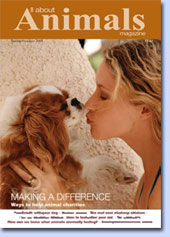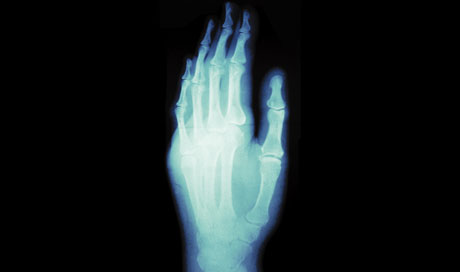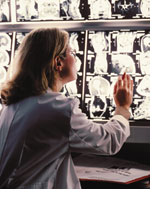- All About Animals
- The magazine for animal lovers.

- For a complimentary copy please telephone 0870 2406871
- Email the Editor

- Write with your opinion on the magazine and life in general after retirement. Click here.
- Register your vote
- Should workers be encouraged by their employers to stay on after retirement?

OSTEOPOROSIS - The risks
Are you living dangerously? It may be exhilarating to risk life and limb on a ski slope or racing at Brands Hatch, but there is no fun in putting your body at risk from osteoporosis.
The risk factors from this potentially crippling disease come in two packs; those you can do nothing about and the ones you can avoid or modify. You need to know about the first type, those which are out of your control, just as much as the second lot. If you were setting off on a long trip into the unknown, you would want to know of any faults or weaknesses in your equipment. On your life journey, similarly, it is important to know the weak spots for you.
Risk Factors 1: Unavoidable
Sex
All along the line, women lose out in the osteoporosis stakes.
Even before the menopause, their bones are lighter and less strong, and from 45 or so, when the female hormones go into reduced production, there is a dramatic – six-fold – difference between
men and women in the prevalence of osteoporosis and its major symptoms – easily broken bones. Even in grand old age, twice
as many women as men have hip fractures.
Age
There is no fooling yourself that age does not signify. Your mind may be Mensa-sharp, your contours sylph-like and even your face lifted to a facsimile of youth, but your bones know precisely how old they are and they function accordingly – slowly shedding mineral strength from age 30 onwards. By the age of 80, 70 per cent of white women in the US and UK have osteoporosis and all but 3 per cent of the rest have osteopenia – light weight bones. People used to think that from about 85 the rhythm of resorption and formation was ticking over so slowly that there was no further bone loss. In fact you go on losing bone density right into your nineties and onwards. There is never a time when you can take your bone for granted.
Your bones are under extra strain in early childhood and adolescence, when they are growing fast, and for women during the hormonal revolution of the menopause – and in the senior years, for everyone.
Late puberty in either sex, and an early menopause in women,
lead to reduced bone mass – a major risk factor. Men do not have such a sharp shut-down of sex hormone production, but by 60 to 65 their bones, too, become more vulnerable. Every year from this age on, whichever your sex, you have to be more on you guard against the danger of a fracture.
Race
Wherever you now live, your bones will remember their ancestry. People of black African descent, especially men, are the most resistant to osteoporosis, and Asian men are the next luckiest. Women of almost all races are more susceptible than the men of the same race. White Caucasian women – the majority in North America and Northern Europe – stand the least chance of getting through life without osteoporosis, unless they take bone-care seriously. White people, across the board, have twice as many fractures from osteoporosis as those from African and Asian backgrounds. Hispanic Americans score midway between whites and blacks
for susceptibility.
A few races buck the trend. Among the Malays and Chinese, men are more liable to osteoporosis than women, and it is more or less evens for the Bantu and the Maoris. These last two have very much less trouble with their bones than people of European descent living in the same region.
Where you live
Although race has a major influence, the country you live in is
also important. Black men and women who have lived for several generations in the States and have absorbed the Western lifestyle have more osteoporosis than their cousins in Africa – although still much less that the whites.
The league table – from places with the largest proportion with osteoporosis down to the least is as follows:
Northern Europe/Scandinavia, North America, Asia, South Pacific, Southern Europe, Africa
In Sweden and other countries in northern latitudes, the sun in winter is so low in the sky that there is a lot of the atmosphere for its rays to penetrate, and much of the ultraviolet does not get through. This interferes with the beneficial effect of sunlight on the manufacture of vitamin D. Vitamin D deficiency is common in these countries, all the more since so few foods provide it (basically only fish liver oil and egg yolk). There is much more osteoporosis in northern Europe than on the sunny Mediterranean coast. Similarly, in Britain there are more cases in Aberdeen than in Bournemouth – but perhaps this is partly due to more oatmeal in the Scottish diet – porridge and oatcakes – inhibiting the absorption of calcium and whisky impeding new bone formation.
When there is less UV light, black and brown people are the likeliest to suffer from vitamin D deficiency. It is not by chance that Scandinavians are pale-skinned and blond, while those from sunny Spain and Italy have olive complexions.
One geographical quirk – the number of new cases of osteoporosis per year has levelled out in the US, but is still escalating in the UK, Sweden, Hong Kong and Australia.
Personal
Your family
Apart from the broad brush strokes of race, your personal hereditary from the family makes a big difference. If one of your parents or another first-degree relative has osteoporosis you could be in line for it – a mother-daughter hand-on is the commonest. Identical twins start with a similar peak bone mass, but this can be blurred later by the effects of smoking, alcohol or other differences in lifestyle.
Your physique
This may be a racial or family trait, or due to early nutrition, but if you are smaller than average and lightly built you may be at greater risk. A hunky black man will have a substantial bone mass to fall back on – you will have less insurance. However, some small, slight Chinese and Japanese people have bones which are just as dense and strong as those of the big guys.
Other factors
Being a twin leads to a lower bone mass.
No kids by the time you have hit the menopause leaves you with a slightly lower bone mass and a slightly increased chance of osteoporosis.
Lactase deficiency (in your genes) or some other cause for an inability to tolerate dairy foods, rich in calcium, is a big disadvantage.
 Medical history – negative factors
Medical history – negative factors
Periods irregular or missing, showing a shortage of oestrogen.
Accidents involving broken bones, causing a reduction of bone mass.
Operations on your stomach or intestines leading to poor absorption of calcium and vitamin D from food.
Hysterectomy with removal of the ovaries, with a dramatic fall in oestrogen production.
Hysterectomy without removal of the ovaries, leading to a temporary reduction in oestrogen (sometimes permanent) and bringing forward the start of the menopause.
Sterilization by tying the tubes, which also reduces oestrogen level.
Prostate or testicle surgery, leading to loss of male hormone.
Chronic illness, particularly those involving immobilisation or inhibition of new bone formation, for instance cancers.
Risk factors 2:
Those you may be able to influence
Caffeine – in excess.
Tobacco – at all.
Alcohol – more than one drink a day. Coffee, ciggies and booze
are enemies which can feel like friends – a pleasure, a comfort,
but more especially a habit.
Sedentary lifestyle or enforced inactivity because of illness
or handicap.
Diet which impairs the absorption of calcium, for example:
wheat bran, beans and wholemeal, containing phytates;
spinach and rhubarb, because of oxalates
too much protein and sodium, causing loss of calcium and high in fast foods and other processed foods low in calcium and high in phosphate and sodium content.
Shortage of vitamins K, C and D.
Lack of trace elements – zinc, manganese, magnesium, copper.
Contraceptive pill – maybe; it seems to have an effect either way, reducing or increasing the BMD.
Not taking hormone replacement therapy after the menopause, although HRT also has dangers.
Poorly developed muscles.
Radiotherapy and chemotherapy.
Medicines interfering with the absorption of calcium:
‘loop’ water pills such as frusemide or triamterene;
tetracycline, and antibiotic;
anticonvulsants;
steroids;
antacids containing aluminium salts;
thyroxine;
isoniazid, used in TB.
Naomi
Emika and Naomi were friends, both working in London for a Japanese firm. Emika came from Tokyo, Naomi from Manchester. Both were 29, small and neat and weighing in at around 50kg. Each thought the other was slightly slimmer and decided to reverse the situation. The result was a competition to see who could eat the least and lose the most. Both were determined characters and neither would give up. It went on for months, with Naomi dipping into anorexia – until the accident.
Naomi was keen on football, she thought it cool. When she fell on the ball and then the ground, her wrist broke. The X-ray in casualty revealed her thinned-out bones – she had osteoporosis. She was shocked to find she had an old ladies’ disease, sever enough to show up on the film. She wondered why Emika, who had done exactly the same slimming, had no problem and a DEXA test showed that her BMD was normal. The difference
was that while Naomi’s weight was low for an English girl, it
was around average for a Japanese; and while Emika’s period continued as usual, Naomi’s were on the blink, making her bones all the more vulnerable.
Naomi is now trying to rebuild her bones with extra calcium
and vitamin D – and a good mixed diet.
Special risks for seniors
It behoves those of retirement age to be considerate of their bones, particularly with regard to falls. A third of their age group have at least one fall a year, of which 6 per cent result in a fracture. Three-quarters of falls which end fatally occur in those over 65 – and they are 99 per cent due to osteoporosis.
The propensity for falls
Causes include:
Impaired sense of balance
Poor muscle control
Slow reaction time and weak muscles, so that you cannot save yourself.
Drugs causing confusion and dizziness, especially sleeping tablets, tranquillizers, sedatives and antidepressants.
Alcohol
Low blood pressure, sometimes due to medicines given to reduce
a high pressure.
Unstable joints, especially the knees.
Arthritis, either rheumatoid or osteoarthritis, affecting how you walk.
Parkinson’s disease.
Impaired vision, hearing and balance organ in the ear (you may not hear traffic until it is very close)
Foot problems – for instance, bunions, corns, callosities or overgrown toenails – affecting walking.
Low calcium level
Calcium is less well absorbed by older people.
Less use of dairy products in this group.
Generally inadequate diet, especially among those living in homes for the elderly.
Other considerations
Older people take less exercise.
Fewer outdoor activities – and less ultraviolet light
Less response to the skin to sunlight – less vitamin D made
Depression of mood, poor memory – may forget to take supplements to diet.
Jessie
Jessie was 72. She has always been very concerned about her appearance, fretting miserably if she put on an extra pound on holiday. She kept her figure trim with diet, but not exercise; this was her first mistake. Walking exercise would have been difficult with the high heels she invariably wore – not quite stilettos, but near. She could not bear the thought of ‘flat barges, like a yokel’. It was a nuisance to find her sight was not as good as it had been, but she did not want to wear glasses in public.
The final straw – not Jessie’s fault – was the freezing.
The pavement was like glass but she did not see it clearly when she slipped and fell crack on her hip. She did quite well with her hip replacement, but would have been walking better if her bones had been stronger. She is now doing daily exercises recommended by the physiotherapist and is improving.
Safety net for seniors
Precautions against falls; shock absorbent flooring, no loose rugs, hand-grips for bath and stairs, good lighting, well-fitting shoes, hip protectors. Hip protectors, oddly, are most beneficial in institutions.
Diet designed to include all necessary nutrients, vitamins
and minerals.
Supplements of calcium and vitamin D.
Daily exercise schedule, preferably walking, but whatever you can manage; extra calcium does not make up for lack of weight-bearing muscular activity.
Treatment for depression, if you are feeling low and without energy or interest.
Review of medicines, with a view to cutting down or out any that are not now necessary.
This extract was taken from Living with Osteoporosis by Dr Joan Gomez, by kind permission of Sheldon Press.
